Magma Sources and Tectonic Settings of Concealed Intrusive Rocks in the Jinchang Ore District, Yanbian–Dongning Region, Northeast China: Zircon U–Pb Geochronological, Geochemical, and Hf Isotopic Evidence
Abstract
:1. Introduction
2. Geological Background
3. Deposit Geology and Sample Descriptions
3.1. Ore District Geology
3.2. Au Mineralization
3.3. Sample Descriptions
4. Analytical Methods
4.1. Zircon U–Pb Dating
4.2. Whole-Rock Major and Trace Element Analyses
4.3. Zircon Hf Isotope Analyses
5. Analytical Results
5.1. Zircon U–Pb Dating
5.2. Major and Trace Element Geochemistry
5.3. Zircon Hf Isotopes
6. Discussion
6.1. Magma Sources
6.2. Tectonic Setting and Implications for Au Metallogeny
7. Conclusions
- (1)
- The zircon U–Pb dating results indicated that the crystallization ages of the concealed monzogranites (GSJ1 and GSJ18) near the J1 auriferous breccia pipe and the No. 18 disseminated Au mineralization in the Jinchang ore district are 202.0 ± 1.6 and 200.9 ± 1.2 Ma, respectively. The concealed granodiorite near the J11 auriferous breccia pipe yielded a younger crystallization age of 107.0 ± 3.0 Ma.
- (2)
- The Early Jurassic monzogranite was derived from the partial melting of the Neoproterozoic–Paleozoic continental crust, whereas the Early Cretaceous granodiorite originated from the mixing magmas of the mantle wedge and the overlying continental crust.
- (3)
- The Early Jurassic ore-hosting monzogranite was formed in the continental arc setting related to the Paleo-Pacific subduction. In contrast, the formation of the ore-causative granodiorite was most likely related to the dehydration and metasomatism of the subducted Paleo-Pacific slab involved in the rollback in the Early Cretaceous.
Supplementary Materials
Author Contributions
Funding
Acknowledgments
Conflicts of Interest
References
- Xiao, W.J.; Windley, B.F.; Hao, J.; Zhai, M.G. Accretion leading to collision and the Permian Solonker suture, Inner Mongolia, China: Termination of the central Asian orogenic belt. Tectonics 2003, 22, 1069–1088. [Google Scholar] [CrossRef] [Green Version]
- Jia, D.C.; Hu, R.Z.; Lu, Y.; Qiu, X.L. Collision belt between the Khanka block and the North China block in the Yanbian Region, Northeast China. J. Asian Earth Sci. 2004, 23, 211–219. [Google Scholar]
- Zhang, Y.B.; Wu, F.Y.; Wilde, S.A.; Zhai, M.G.; Lu, X.P.; Sun, D.Y. Zircon U–Pb ages and tectonic implications of “Early Paleozoic” granitoids at Yanbian, Jilin Province, NE China. Isl. Arc 2004, 13, 484–505. [Google Scholar] [CrossRef]
- Li, J.Y. Permian geodynamic setting of Northeast China and adjacent regions: Closure of the Paleo-Asian Ocean and subduction of the Paleo-Pacific Plate. J. Asian Earth Sci. 2006, 26, 207–224. [Google Scholar] [CrossRef]
- Yang, J.H.; Wu, F.Y.; Shao, J.A.; Wilde, S.A.; Xie, L.W.; Liu, X.M. Constraints on the timing of uplift of the Yanshan Fold and Thrust Belt, North China. Earth Planet. Sci. Lett. 2006, 246, 336–352. [Google Scholar] [CrossRef]
- Wu, F.Y.; Sun, D.Y.; Ge, W.C. Geochronology of the Phanerozoic granitoids in northeastern China. J. Asian Earth Sci. 2011, 41, 1–30. [Google Scholar] [CrossRef] [Green Version]
- Liu, S.; Hua, R.Z.; Gao, S.; Feng, C.X.; Coulsonc, I.M.; Feng, G.Y.; Qi, Y.Q.; Yang, Y.H.; Yang, C.G.; Tang, L. Zircon U–Pb age and Sr–Nd–Hf isotopic constraints on the age and origin of Triassic mafic dikes, Dalian area, Northeast China. Int. Geol. Rev. 2013, 55, 249–262. [Google Scholar] [CrossRef]
- Xu, W.L.; Wang, F.; Pei, F.P.; Meng, N.; Tang, J.; Xu, M.J.; Wang, W. Mesozoic tectonic regimes and regional ore-forming background in NE China: Constraints from spatial and temporal variations of Mesozoic volcanic rock associations. Acta Petrol. Sin. 2013, 29, 339–353, (In Chinese with English Abstracrt). [Google Scholar]
- Cai, W.Y.; Wang, Z.G.; Li, J.; Fu, L.J.; Wang, K.Y.; Konare, Y. Zircon U-Pb and molybdenite Re-Os geochronology and geochemistry of Jinchang porphyry gold-copper deposit, NE China: Two-phase mineralization and the tectonic setting. Ore Geol. Rev. 2019, 107, 735–753. [Google Scholar] [CrossRef]
- Ren, Y.S.; Chen, C.; Zou, X.T.; Zhao, H.L.; Hao, Y.J.; Hou, H.N.; Hu, Z.C.; Jia, G.H. The age, geological setting, and types of gold deposits in the Yanbian and adjacent areas, NE China. Ore Geol. Rev. 2016, 73, 284–297. [Google Scholar] [CrossRef]
- Chai, P.; Sun, J.; Xing, S.; Men, L.; Han, J. Early Cretaceous arc magmatism and high-sulphidation epithermal porphyry Cu–Au mineralization in Yanbian area, Northeast China: The Duhuangling example. Int. Geol. Rev. 2014, 57, 1267–1293. [Google Scholar] [CrossRef]
- Wang, Z.G. Mineralization and Metallogenic Prediction of the Jinchang Cu-Au Deposit in Dongning, Heilongjiang Province. Ph.D. Thesis, Jilin University, Changchun, China, 2018. (In Chinese). [Google Scholar]
- Li, S.D.; Wang, Z.G.; Wang, K.Y.; Cai, W.Y.; Peng, D.W.; Xiao, L.; Li, J. Re-Os Pyrite Geochronological Evidence of Three Mineralization Styles within the Jinchang Gold Deposit, Yanji-Dongning Metallogenic Belt, Northeast China. Minerals 2018, 8, 448. [Google Scholar] [CrossRef] [Green Version]
- Shi, K.T.; Wang, K.Y.; Yu, H.J.; Wang, Z.G.; Ma, X.L.; Bai, X.J.; Wang, R. The 40Ar/39Ar dating of quartz: New insights into the metallogenic chronology of the Jinchang gold deposit and its geological significance. Sci. Rep. 2018, 8, 13879. [Google Scholar] [CrossRef] [PubMed]
- Zhao, Y.S. Porphyry Gold System of the Jinchang Camp in the Yanbian-Dongning Metallogenic Belt, NE China. Ph.D. Thesis, China University of Geosciences, Beijing, China, 2013. (In Chinese). [Google Scholar]
- Wang, Z.G.; Wan, D.; Wang, K.Y.; Konare, Y.; Liang, Y.H. Isotope systematics and fluid inclusion studies of the Hongtaiping Cu–Pb–Zn deposit in Yanbian, NE China: Implications for ore genesis. Geol. J. 2020, 55, 6912–6935. [Google Scholar] [CrossRef]
- Tang, K.D.; Shao, J.A.; Li, J.C.; Kang, Z. Nature of the Yanbian suture zone and structure of Northeast Asian. Geol. Bull. China 2004, 23, 885–891, (In Chinese with English Abstract). [Google Scholar]
- Zhang, C. The Mesozoic Tectonic Evolution of Yanbian Area in the Eastern Segment of Northern Margin of the North China Block. Ph.D. Thesis, Jilin University, Changchun, China, 2014. (In Chinese). [Google Scholar]
- Wu, F.Y.; Sun, D.Y.; Lin, Q. Petrogenesis of the Phanerozoic granites and crustal growth in Northeast China. Acta Petrol. Sin. 1999, 15, 181–189, (In Chinese with English Abstract). [Google Scholar]
- Cao, H.H.; Xu, W.L.; Pei, F.P.; Wang, Z.W.; Wang, F.; Wang, Z.J. Zircon U–Pb geochronology and petrogenesis of the Late Paleozoic–Early Mesozoic intrusive rocks in the eastern segment of the northern margin of the North China Block. Lithos 2013, 170–171, 191–207. [Google Scholar] [CrossRef]
- Zhang, Y.B.; Wu, F.Y.; Wilde, S.A.; Zhai, M.G.; Lu, X.P.; Zhang, X.F. Geochronology and Tectonic Implications of the “Proterozoic” Seluohe Group at the Northern Margin of the North China Craton. Int. Geol. Rev. 2008, 50, 135–153. [Google Scholar] [CrossRef]
- Zhang, Y.B.; Wu, F.Y.; Sun, D.Y.; Li, H.M. Single grain zircon U–Pb ages of the “Early Hercynian” Miantian granites and Zhongping hypersthene diorite in the Yanbian area. Geol. Rev. 2002, 48, 424–429, (In Chinese with English Abstract). [Google Scholar]
- Wang, Z.W.; Pei, F.P.; Xu, W.L.; Cao, H.H.; Wang, Z.J.; Zhang, Y. Tectonic evolution of the eastern Central Asian Orogeni Belt: Evidence from zircon U-Pb-Hf isotopes and geochemistry of early Paleozoic rocks in Yanbian region, NE China. Gondwana Res. 2016, 28, 334–350. [Google Scholar] [CrossRef]
- Shan, P.F.; Cao, M.J.; Jourdan, F.; Evans, N.; Ge, X.; Sun, J.G.; Qin, K.Z.; Zhao, C. Biotite 40Ar/39Ar dating and chemical composition inform metallogenesis of Xiaoxi’nancha porphyry Au-Cu deposit, NE China. Ore Geol. Rev. 2021, 134, 104140. [Google Scholar] [CrossRef]
- Han, S.J.; Yang, Y.C.; Ye, S.Q.; Khomich, V.G.; Boriskina, N.G.; Wang, X.Y. U–Pb zircon and geochemical constraints on age and genesis ofgranitoids from the Jinchang Au deposit in Heilongjiang, NE China. Geol. J. 2018, 53, 600–616. [Google Scholar] [CrossRef]
- Zhao, Y.J.; Sun, J.G.; Wang, Q.H.; Men, L.J.; Li, Y.X.; Guo, J.; Cui, P.L. 40Ar/39Ar laser probe dating and discussion on metallogenic epoch of epithermal Au-Cu deposit in Yanbian area of Jilin. Earth Sci. Front. 2010, 17, 156–169, (In Chinese with English abstract). [Google Scholar]
- Men, L.J. An Ore-forming Fluid Study on Late Mesozoic Epithermal Au–Cu Deposit in Yanbian-Dongning Area: Implication for the Metallogenic Mechanism. Ph.D. Thesis, Jilin University, Changchun, China, 2011. (In Chinese). [Google Scholar]
- Men, L.J.; Sun, J.G.; Zhao, J.K.; Chen, L.; Liang, S.N.; Pang, W.; Chen, D. Fluidinclusions in breccia type copper gold ore bodies of Jinchang gold deposit, Dongning county, Heilongjiang province. Miner. Depos. 2008, 27, 71–80, (In Chinese with English abstract). [Google Scholar]
- Zhang, H.F.; Li, S.R.; Santosh, M.; Liu, J.J.; Diwu, C.R.; Zhang, H. Magmatism and metallogeny associated with mantle upwelling: Zircon U-Pb and Lu–Hf constraints from the gold-mineralized Jinchang granite, NE China. Ore Geol. Rev. 2013, 54, 138–156. [Google Scholar] [CrossRef]
- Lu, Y.H.; Zhang, Y.; Lai, Y.; Wang, Y.Z. LA–ICP–MS zircon U-Pb dating of magmatism and mineralization in the Jinchang gold ore-field, Heilongjiang province. Acta Petrol. Sin. 2009, 25, 2902–2912, (In Chinese with English Abstract). [Google Scholar]
- Ma, F. Study on the Enrichment Regularity of Mineralization of Jinchang Gold Deposit, Dongning in Heilongjiang Province. Ph.D. Thesis, Jilin University, Changchun, China, 2014. (In Chinese). [Google Scholar]
- Xu, W.X. Geological Characters, Metallogenic Regularity and Model of the Gold (Copper) Ore Fields in Jinchang, Heilongjiang province. Ph.D. Thesis, China University of Geosciences, Beijing, China, 2009. (In Chinese). [Google Scholar]
- Yuan, H.L.; Gao, S.; Liu, X.M. Accurate U-Pb age and trace element determinations of zircon by laser ablation inductively coupled plasma mass spectrometry. Geostand. Geoanal. Res. 2004, 28, 353–370. [Google Scholar] [CrossRef]
- Liu, Y.S.; Hu, Z.C.; Gao, S.; Günther, D.; Xu, K.J.; Gao, C.G.; Chen, H.H. In situ analysis of major and trace elements of anhydrous minerals by LA-ICP-MS without applying an internal standard. Chem. Geol. 2008, 257, 34–43. [Google Scholar] [CrossRef]
- Liu, Y.S.; Gao, S.; Hu, Z.C.; Gao, C.G.; Zong, K.Q.; Wang, D.B. Continental and oceanic crust recycling-induced melt-peridotite interactions in the Trans-North China Orogen: U-Pb dating, Hf isotopes and trace elements in zircons from mantle xenoliths. J. Petrol. 2010, 51, 537. [Google Scholar] [CrossRef]
- Ludwig, K.R. User’s manual for Isoplot/EX version 3.0: A geochronologicaltoolkit for Microsoft Excel. Berkeley Geochronol. Cent. Spec. Publ. 2003, 4, 70. [Google Scholar]
- Wu, F.Y.; Yang, Y.H.; Xie, L.W.; Yang, J.H.; Xu, P. Hf isotopic compositions of the standard zircons and baddeleyites used in U-Pb geochronology. Chem. Geol. 2006, 234, 105–126. [Google Scholar] [CrossRef]
- Griffin, W.L.; Pearson, N.J.; Belousova, E.; Jackson, S.E.; Van Achterbergh, E.; O’Reilly, S.Y.; Shee, S.R. The Hf isotope composition of cratonic mantle: LAM-MC-ICPMS analysis of zircon megacrysts in kimberlites. Geochim. Acta 2000, 64, 133–147. [Google Scholar] [CrossRef]
- Nowell, G.M.; Kempton, P.D.; Noble, S.R.; Fitton, J.G.; Saunders, A.D.; Mahoney, J.J.; Taylor, R.N. High precision Hf isotopemeasurements ofMORB and OIB by thermal ionization mass spectrometry: Insights into the depleted mantle. Chem. Geol. 1998, 149, 211–233. [Google Scholar] [CrossRef]
- Belousova, E.A.; Griffin, W.L.; O’Reilly, S.Y. Igneous zircon: Trace element composition as an indicator of source rock type. Contrib. Mineral. Petrol. 2002, 143, 602–622. [Google Scholar] [CrossRef]
- Hoskin, P.W.O.; Schaltegger, U. The composition of zircon and igneous and metamorphic petrogenesis. Rev. Mineral. Geochem. 2003, 53, 27–62. [Google Scholar] [CrossRef]
- Peccerillo, A.; Taylor, S.R. Geochemistry of eocene calc–alkaline volcanic rocks from the Kastamonu area, Northern Turkey. Contrib. Mineral. Petrol. 1976, 58, 63–81. [Google Scholar] [CrossRef]
- Maniar, P.D.; Piccoli, P.M. Tectonic discrimination of granitoids. Geol. Soc. Am. Bull. 1989, 101, 635–643. [Google Scholar] [CrossRef]
- Sun, S.S.; McDonough, W.F. Chemical and isotopic systematics of oceanic basalts: Implications for mantle composition and processes. In Magmatism in theOcean Basins; Saunders, A.D., Norry, M.J., Eds.; Geological Society London Special Publications: London, UK, 1989; Volume 42, pp. 313–345. [Google Scholar]
- Weaver, B.L. The origin of ocean island basalt end member compositions: Trace element and isotopic constraints. Earth Planet. Sci. Lett. 1991, 101, 381–397. [Google Scholar] [CrossRef]
- Rapp, R.P.; Watson, E.B. Dehydration melting of metabasalt at 8–32 kbar: Implications for continental growthand crust–mantlerecycling. J. Petrol. 1995, 36, 891–931. [Google Scholar] [CrossRef]
- Wu, F.Y.; Li, X.H.; Zheng, Y.F.; Gao, S. Lu-Hf isotopic systematics and their applications in petrology. Acta Petrol. Sin. 2007, 23, 185–220, (In Chinese with English abstract). [Google Scholar]
- Li, S.D.; Zhang, X.B.; Gao, L.L. Ore Genesis at the Jinchang Gold–Copper Deposit in Heilongjiang Province, Northeastern China: Evidence from Geology, Fluid Inclusions, and H–O–S Isotopes. Minerals 2019, 9, 99. [Google Scholar] [CrossRef] [Green Version]
- Saunders, A.D.; Norry, M.J.; Tarney, J. Origin of MORB and chemically-depleted mantle reservoirs: Trace element constraints. J. Petrol. Spec. Vol. 1988, 1, 415–445. [Google Scholar] [CrossRef]
- Mao, J.W.; Zhang, Z.C.; Zhang, Z.H.; Du, A.D. Re–Os isotopic dating of molybdenites in the Xiaoliugou W (Mo) deposit in the northern Qilian mountains and its geologicalsignificance. Geochim. Cosmochim. Acta 1999, 63, 1815–1818. [Google Scholar]
- Shirey, S.B.; Walker, R.J. Carius tube digestion for low-blank rhenium-osmium analysis. Anal. Chem. 1995, 67, 2136–2141. [Google Scholar] [CrossRef]
- Palmer, M.R.; Turekian, K.K. 187Os/186Os in marine manganese nodules and the constraints on the crustal geochemistry of rhenium and osmium. Nature 1986, 319, 216–220. [Google Scholar] [CrossRef]
- Zhang, H.F.; Gao, S. Geochemistry; Geology Press: Beijing, China, 2012; pp. 232–238. (In Chinese) [Google Scholar]
- Yang, H.; Ge, W.C.; Zhao, G.C.; Dong, Y.; Xu, W.L.; Ji, Z.; Yu, J.J. Late Triassic intrusive complex in the Jidong region, Jiamusi–Khanka Block, NE China: Geochemistry, zircon U–Pb ages, Lu–Hf isotopes, and implications for magma mingling and mixing. Lithos 2015, 224–225, 143–159. [Google Scholar] [CrossRef]
- Pearce, J.A.; Harris, N.B.W.; Tindle, A.G. Trace element discrimination diagrams for the tectonic interpretation of granitic rocks. J. Petrol. 1984, 25, 956–983. [Google Scholar] [CrossRef] [Green Version]
- Harris, N.B.W.; Pearce, J.A.; Tindle, A.G. Geochemical characteristics of collision-zone magmatism. Geol. Soc. Lond. Spec. Publ. 1986, 19, 67–81. [Google Scholar] [CrossRef]
- Zhang, Z.C.; Mao, J.W.; Wang, Y.B.; Pirajno, F.; Liu, J.L.; Zhao, Z.D. Geochemistryand geochronology of the volcanic rocks associated with the Dong’an adularia–sericite epithermal gold deposit, Lesser Hinggan Range, Heilongjiang province, NE China: Constraints on the metallogenesis. Ore Geol. Rev. 2010, 37, 158–174. [Google Scholar] [CrossRef]
- Zhang, G.B.; Yang, Y.C.; Wang, J.; Wang, K.Y.; Ye, S.Q. Geology, geochemistry, and genesis of the hot-spring-type Sipingshan gold deposit, eastern Heilongjiang province, Northeast China. Int. Geol. Rev. 2013, 55, 482–495. [Google Scholar] [CrossRef]
- Shu, Q.H.; Chang, Z.; Lai, Y.; Zhou, Y.; Sun, Y.; Yan, C. Regional metallogeny of Mo-bearing deposits in northeastern China, with new Re-Os dates of porphyry Mo deposits in the northern Xilamulun district. Econ. Geol. 2016, 111, 1783–1798. [Google Scholar] [CrossRef]
- Kiminami, K.; Imaoka, T. Spatiotemporal variations of Jurassic-Cretaceous magmatism in eastern Asia (Tan-Lu fault to SW Japan): Evidence for flat-slab subduction and slab rollback. Terra Nova 2013, 25, 414–422. [Google Scholar] [CrossRef]
- Sun, M.D.; Chen, H.L.; Zhang, F.Q.; Wilde, S.A.; Dong, C.W.; Yang, S.F. A 100 Ma bimodal composite dyke complex in the Jiamusi block, northeastern China: An indication for lithospheric extension driven by Paleo-Pacifc roll-back. Lithos 2013, 162–163, 317–330. [Google Scholar] [CrossRef]
- Lallemand, S.; Heuret, A.; Boutelier, D. On the relationships between slab dip, back-arc stress, upper plate absolute motion, and crustal nature in subduction zones. Geochem. Geophys. Geosyst. 2005, 6, 259. [Google Scholar] [CrossRef] [Green Version]
- Maruyama, S.; Okamoto, K. Water transportation from the subducting slab into the mantle transition zone. Gondwana Res. 2007, 11, 148–165. [Google Scholar] [CrossRef]
- Yuan, C.; Sun, M.; Xiao, W.J.; Wilde, S.; Li, X.H.; Liu, X.H.; Long, X.P.; Xia, X.P.; Ye, K.; Li, J.L. Garnet-bearing tonalitic porphyry from East Kunlun, Northeast Tibetan Plateau: Implications for adakite and magmas from the MASH Zone. Int. J. Earth Sci. 2009, 98, 1489–1510. [Google Scholar] [CrossRef]
- Hoffer, G.; Eissen, J.P.; Beate., B. Geochemical and petrological constraints on rear-arc magma genesis processes in Ecuador: The Puyo cones and Mera lavas volcanic formations. J. Volcanol. Geotherm. Res. 2008, 176, 107–118. [Google Scholar] [CrossRef]
- Chen, L.; Tang, L.M.; Yang, J.C.; Li, X.H.; Wang, W.; Chu, F.Y.; Zhang, J. Petrogenesis and tectonic implication of lavas from the Yap Trench, western Pacific. Acta Oceanol. Sin. 2021, 40, 147–161. [Google Scholar] [CrossRef]
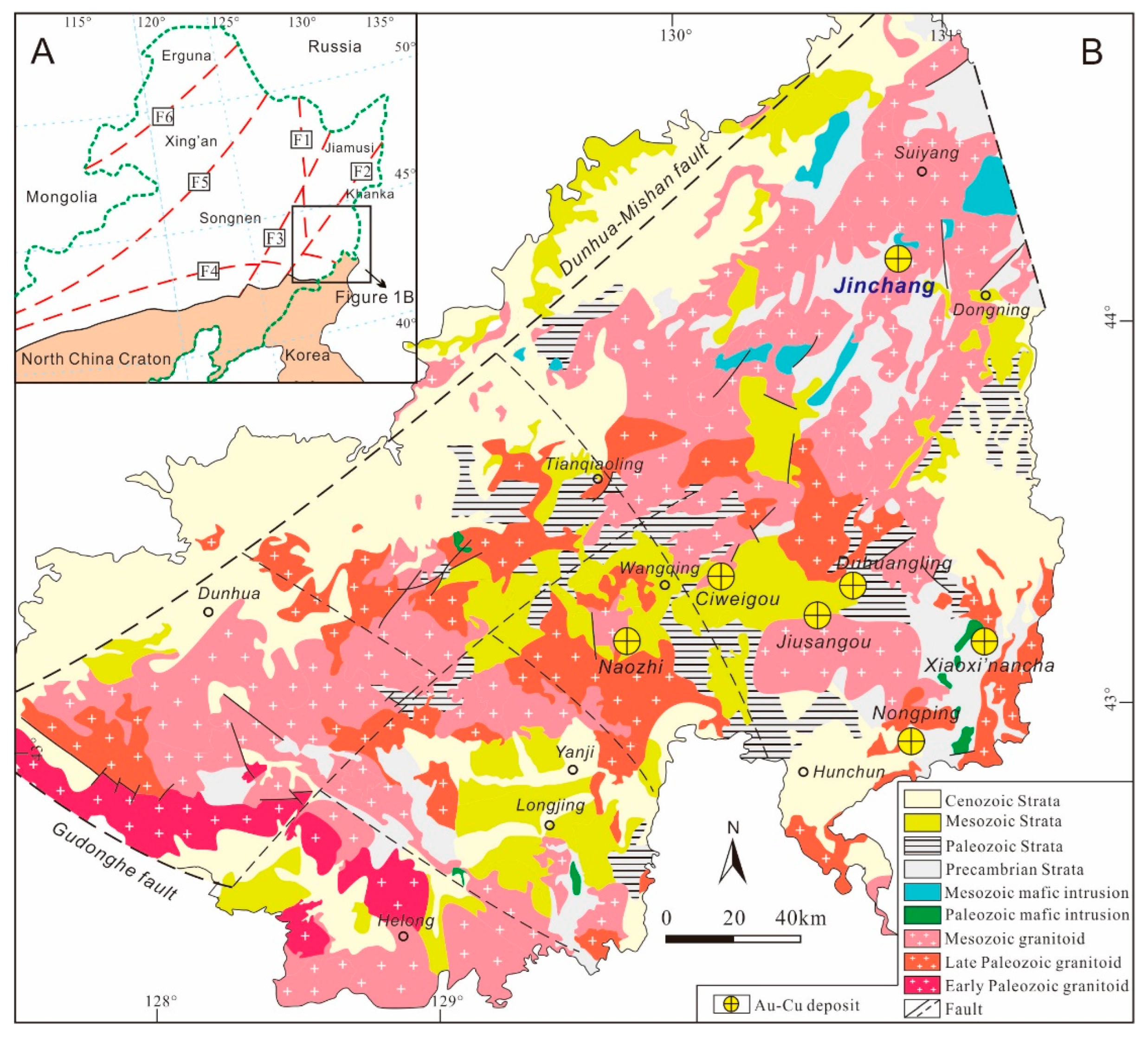

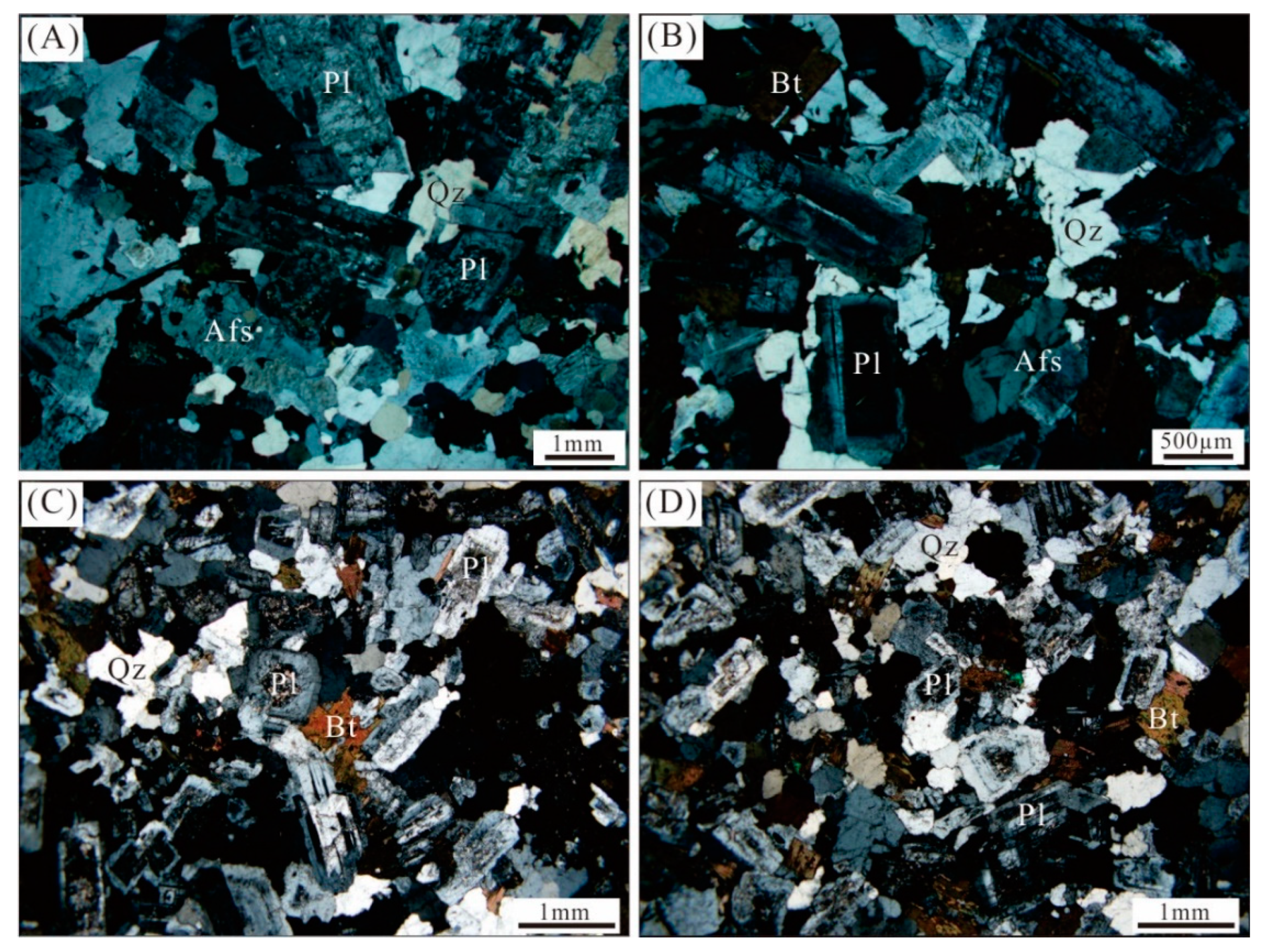

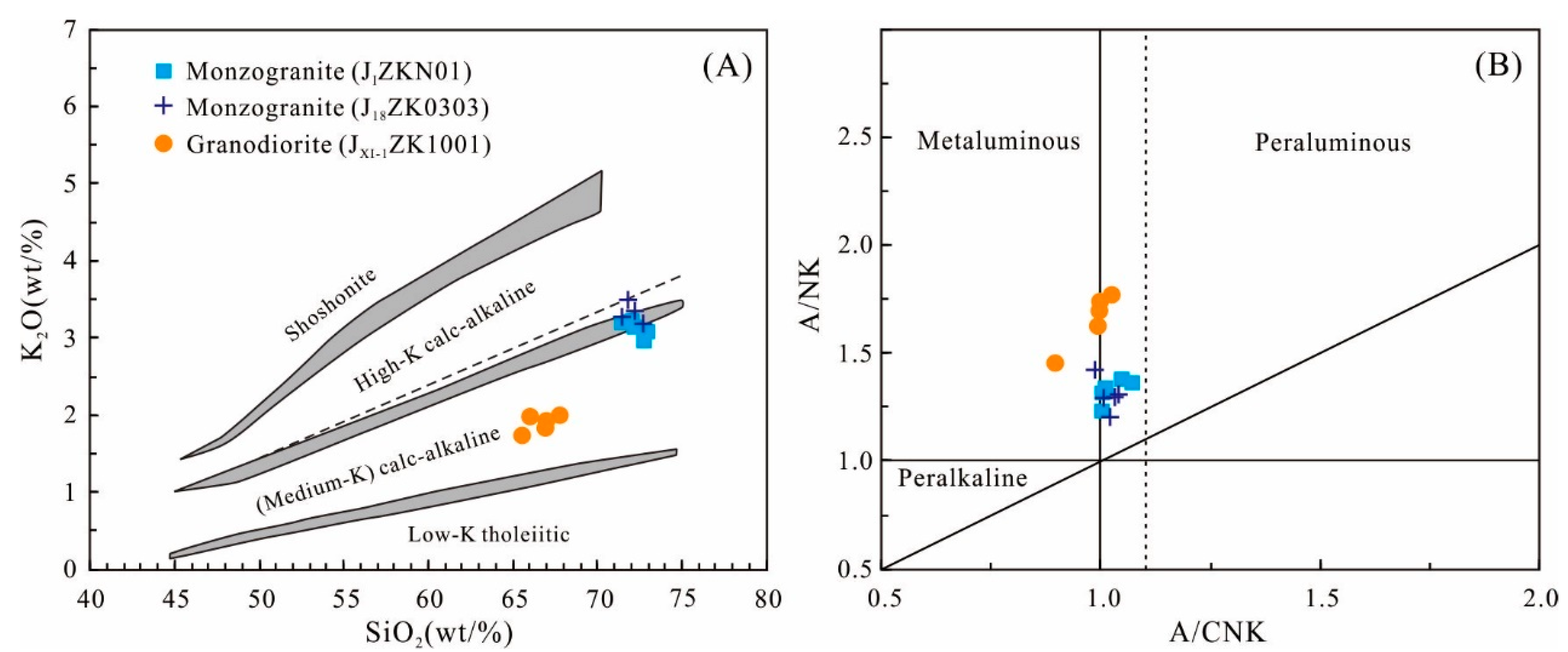
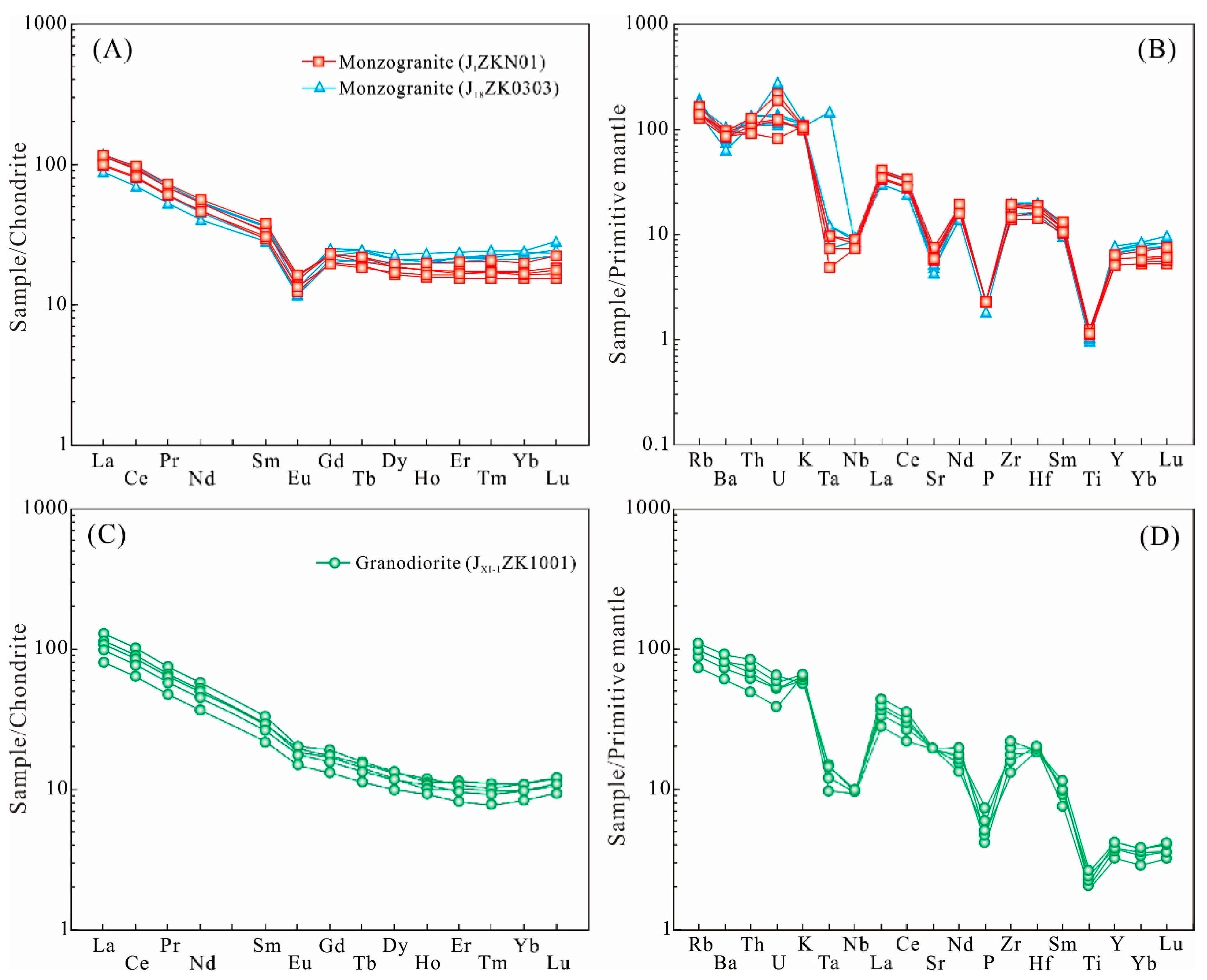


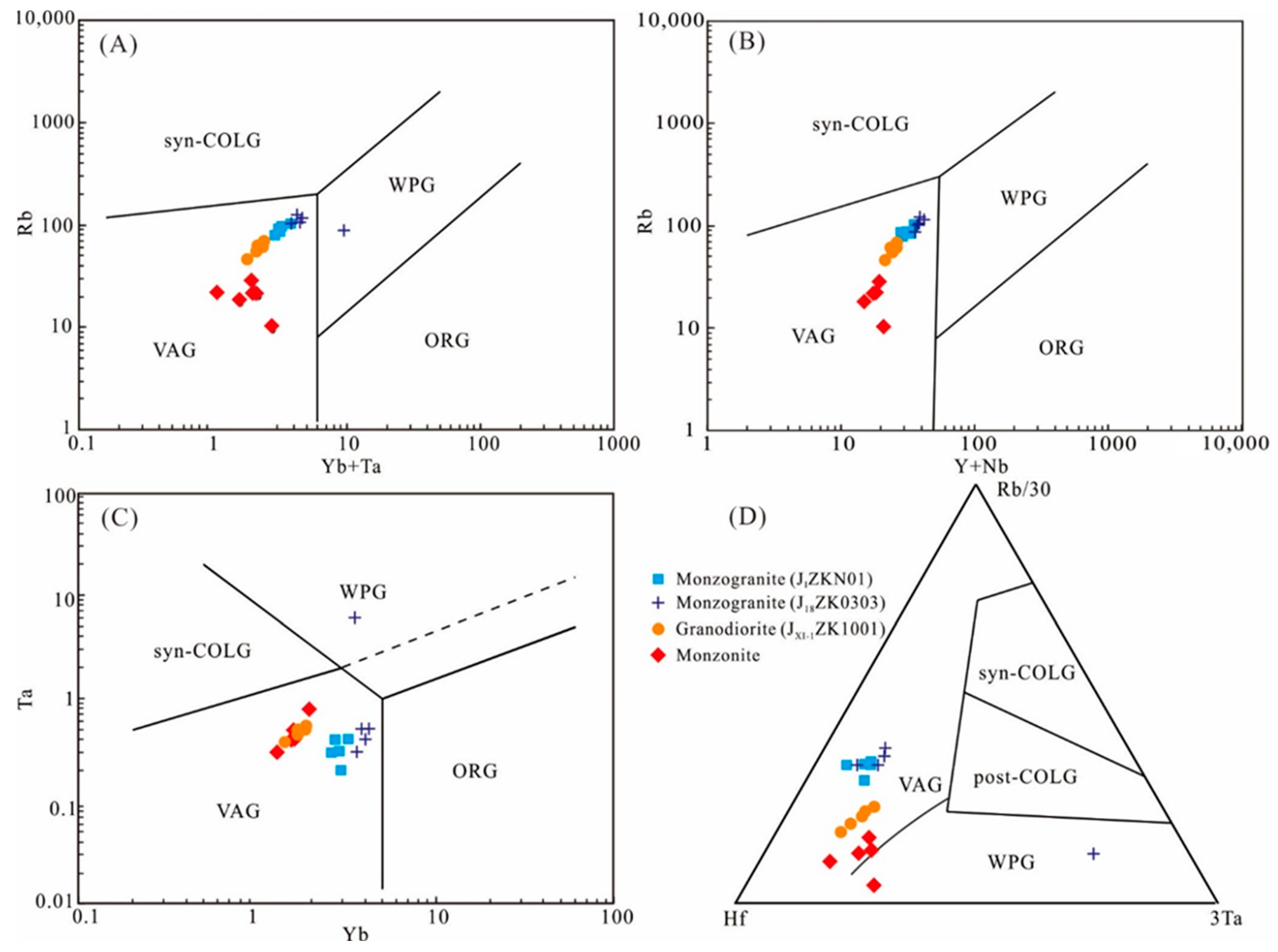


Publisher’s Note: MDPI stays neutral with regard to jurisdictional claims in published maps and institutional affiliations. |
© 2022 by the authors. Licensee MDPI, Basel, Switzerland. This article is an open access article distributed under the terms and conditions of the Creative Commons Attribution (CC BY) license (https://creativecommons.org/licenses/by/4.0/).
Share and Cite
Wang, Z.; Cai, W.; Li, S.; Ma, X. Magma Sources and Tectonic Settings of Concealed Intrusive Rocks in the Jinchang Ore District, Yanbian–Dongning Region, Northeast China: Zircon U–Pb Geochronological, Geochemical, and Hf Isotopic Evidence. Minerals 2022, 12, 708. https://doi.org/10.3390/min12060708
Wang Z, Cai W, Li S, Ma X. Magma Sources and Tectonic Settings of Concealed Intrusive Rocks in the Jinchang Ore District, Yanbian–Dongning Region, Northeast China: Zircon U–Pb Geochronological, Geochemical, and Hf Isotopic Evidence. Minerals. 2022; 12(6):708. https://doi.org/10.3390/min12060708
Chicago/Turabian StyleWang, Zhigao, Wenyan Cai, Shunda Li, and Xuli Ma. 2022. "Magma Sources and Tectonic Settings of Concealed Intrusive Rocks in the Jinchang Ore District, Yanbian–Dongning Region, Northeast China: Zircon U–Pb Geochronological, Geochemical, and Hf Isotopic Evidence" Minerals 12, no. 6: 708. https://doi.org/10.3390/min12060708




